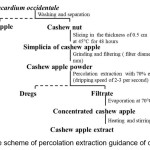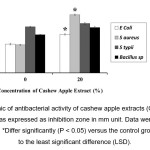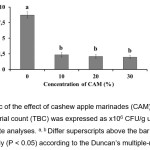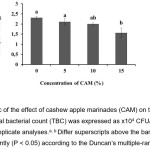Introduction
Meat is a perishable food and one of factors that led to meat spoilage is microbial growth.1 Commonly, meat supply in Indonesia is organized by abattoirs where its yields afterward slaughtered, distributed or consumed allows potentially contaminated with microbes. Microbial activities on meat cause physical and functional alteration with the result that decrease in quality and shelf life.
According to the National Standardization Agency of Indonesia, microbiological quality requirement by using Total Plate Count (TPC) test on meat is a maximum of 106 CFU/g. When the total bacteria of meat are higher than an established standard, meat is not feasible anymore as food because it was perishable. In addition, pathogenic bacteria exposed meat will be a potential source for food borne disease when it was consumed by human. Therefore, to get more optimum usefulness and quality of meat especially in the point of view of microbiological aspect, addition of an active ingredient on meat through the marinating process is necessary to be done.
In the beginning, marinating was just as seasoning. In the latter case, marinating is also play a role for suppressing meat bacteria due to the bioactive constituent containing in the marinade.2,3 Thus marinating can be advantaged as a method to prolong the shelf life, increase the added value, and assure the food safety on meat or its products. It has been known that kind of organic acid, flavonoid, and polyphenol contained in the fruits extract commonly used as a natural marinades ingredient that is safe for health.4 Principally, vitamin C and flavonoid have a function as antioxidant while polyphenol can play a role as antibacterial. In this study, we used cashew apple as a promising marinade because of its highly polyphenol and organic acids content.5 All this time, cashew apple only has been being a waste in cashew nut industry. When cashew nut became the high valuable food, cashew apple was often considered as by-product with estimation of worldwide production about 30 million ton.6 Previous studies reported that cashew apple juice contain antibacterial property having potential to inhibit human pathogens Staphylococcus aureus.7,8 It was interested to explore the utilization of cashew apple as marinade solution to suppress the meat bacteria.
Therefore, current study was aimed to get more insight the effectiveness of cashew apple extract marinade (CAM) as growth inhibitor for spoilage bacteria on beefs and chickens. This investigation was contributed in order to get an alternative ingredient for fresh meat preservative. Moreover, this study also provided the scientific basic regarding to the application of natural preservative material for food that was biodegradable, non-residue, and safe for consumer health. Overall, this finding was expected can promote the economic and social development in the light of Indonesia as one of the biggest cashew nut producer in the world overtake Mozambique, India, and Brazil.
Materials and Methods
Collection of cashew apples
The ripe cashew apples were collected from some farmers located at the district of Wonogiri, Central Java Province, Indonesia. Those samples were brought immediately to laboratory and washed well with clean water to release cashew apples from of impurities.
Preparation of cashew apples extracts (CAE)
Extraction of cashew apple was performed by using percolation method. Solvent used in that percolation extraction was 70% ethanol. Extraction was initiated by grinding of cashew apple simplisia followed by percolation stage and finally obtained cashew apple in ethanol extract. The entire of extraction process was illustrated in the Figure 1. The yields obtained from that process were calculated for its total phenolic and flavonoids content by using Folin-Ciocalteau method.9 Briefly, 200 μl of the appropriately diluted crude extract were added to 1.9 mL of freshly diluted 10-fold Folin–Ciocalteau reagent. The same volume (1.9 mL) of a sodium carbonate solution (60 g/L) was used to neutralize the mixture. After a 120-min reaction in the dark, at room temperature, the absorbance of the mixture was measured at 725 nm. Ferulic acid was used as a standard, and results were expressed as mg of ferulic acid equivalents (FAE) per g of extract. Meanwhile the total flavonoid content of CAE was determined using the Dowd method.10 5 mL of 2 % aluminium trichloride (AlCl3) in methanol was mixed with the same volume of the extract solution (0.4 mg/mL). Absorption readings at 415 nm using PerkinElmer UVVIS lambda 25 spectrophotometer were taken after 10 minutes against a blank sample consisting of a 5 mL extract solution with 5 mL methanol without AlCl3. The total flavonoid content was determined using a standard curve with catechin (0 – 100 mg/L) as the standard. Total flavonoid content is expressed as mg of catechin equivalents (CE) per g of extract.
Antibacterial activity assay of CAE
Before being applied as marinade solution, antibacterial potency of CAE was tested by using disc diffusion method11. First of all, medium of nutrient agar (NA) and bacteria culture equipments were sterilized by autoclave at 121oC for 15 minutes. Bacteria cultures such as E. coli, S. aureus, S. typhi, and Bacillus sp in nutrient broth (NB) medium were shaken out by vortex, poured into NA (ratio of indicated bacteria and NA was 1:20 in v/v) and homogenized thoroughly. Bacteria cultures were incubated at optimum growth temperature for 24 hours until mediums were turbid with 108-109 colony /ml in density. Inoculated NA-mediums were poured for 15-20 ml on petri dish and allowed to solidify at the room temperature. Discs in 5 mm diameter were passed away over the Bunsen burner and then dipped into the solution of 20% cashew apple extract. Those discs were laid on the bacteria inoculated NA-mediums surface and then incubated at the room temperature for 24 hours. Finally the diameter of inhibition zones located around the discs was measured.
Inhibitory activity assay of cashew apple extract marinades (CAM)
First of all, beef and chickens were prepared as meat samples in this study. Chicken breast fillets were purchased from a local retail outlet and cut into pieces of similar dimensions weighing about 40 g each. Beef samples (tenderloin) were purchased from a major butchery in the city. All fat were removed from the sample and then cut manually about 1 cm in thick and weighed about 60 g each. Before marinating process was done, all samples were kept in the refrigerator at 5oC.
Cashew apple marinated (CAM) was prepared in serial dilution by dissolving CAE into the sterile distillate water. Concentration level of CAM for chicken meat marinating was determined to 0, 5, 10, and 15 % while beef marinating was 0, 10, 20, and 30 %. Simultaneously, each sample was soaked in the dish with indicated concentration of CAM for 4 hours. No addition of CAE (0 % concentration) was considered as a control in this study. Post marinating step, samples were taken out from the dish, drained, and kept in plastic bags before total bacteria of meat was evaluated.
Total bacteria were calculated by total plate count (TPC) method. Principle of this method is calculating all coloni formed by bacteria. Activities related to TPC technique was under sterile condition. First of each samples were dipped in 45 ml of destilatte water for 10 minutes. Sample solution was dilluted to desired final dillution level. 1 ml of each samples solution was poured into petri dishes followed by pouring on of 20 ml of NA medium. It was allowed to coagulate at the room temperature. Petri dishes were incubated at 37oC in upside down condition. After 24 hours incubation, the number of colony was calculated by colony counter assistance. Counted colony number was corrected by its dilution factor. Total bacteria were expressed as log CFU/mL.
Statistical analysis
One-way ANOVA was used to identify the difference levels of CAM for some indicated parameters. For group differences, post hoc multiple comparison Duncan multiple range tests (DMRT) were used to analyse meat total bacteria, while least significant difference (LSD) was used to analyse antibacterial activity of CAM. Statistical analyses were performed using SPSS for Windows. P < 0.05 was considered statically significant.12
Results and Discussion
Antibacterial activity of CAE
Previous study successfully revealed the potency of cashew apple as antibacterial to human pathogens. Cashew apple juice showed inhibit zone of Staphylococcus aureus isolates. Inhibition zone reached cashew apple juice was equal with antibiotic of Tetracycline in that study. However, bioactive components responsible for antibacterial activity of cashew apple as well as its level of efficacy have not been elucidated clearly. Through this study, we extracted cashew apple in order to get the bioactive constituent possesses the antibacterial activity (Fig. 1). The yield obtained from extraction process was determined phenolic and flavonoid content subsequently. It has been known that both compound are board spectrum antibacterial produced from plants.13 Based on the spectrophotometer analysis, total phenolic content of CAE was quite higher than total flavonoids content (Table 1). It was suggested that phenolic compound likely a substance responsible for antibacterial activity of cashew apple extract. That fact was more clarified by antibacterial activity test of CAE in this study wherein 20 % concentrations extract compare with distillate water as a control, able to increase the inhibition zone toward E coli dan S aureus significantly (Fig. 2). The biggest inhibition zone was visible occur to S aureus, suggested that cashew apple inhibits bacterial growth effectively so that ingredients can be applied as food preservative.
 |
Figure 1: The scheme of percolation extraction guidance of cashew apple Click here to View figure |
Table 1: Level of bioactive component of CAE
|
Active compound |
Concentration |
|
Total flavonoids (mg of CE/g of extract) |
0.14 |
| Total phenolic (mg of TAE/g of extract) |
13.3 |
CE : Catechin Equivalents
TAE : Tannic Acid Equivalents
 |
Figure 2: Graphic of antibacterial activity of cashew apple extracts (CAE). Inhibitory efficacy of CAE was expressed as inhibition zone in mm unit. Data were mean ± SD of 4 replicate analyses. *Differ significantly (P < 0.05) versus the control group (0%) according to the least significant difference (LSD) Click here to View figure |
As a pathogen bacteria, Staphylococcus aureus (Staph) is found on the skin and in the nose of about 25% of healthy people and animals.14 It usually does not cause illness in healthy people, but Staph has the ability to make toxins that can cause food poisoning. Staphylococcal food poisoning is a gastrointestinal illness caused by eating foods contaminated with toxins produced by the bacterium Staphylococcus aureus.15 Meanwhile inhibition activity of cashew apple toward E coli showed that material was potent to control pathogenic bacteria that threaten human health. Although most types of E. coli are harmless, some types can make people sick especially when bacteria play a role as food contaminant, for example undercooked ground meat.16
Inhibitory activity of CAM on the total meat bacteria
In order to establish the application of cashew apple related to food safety, its extract was used as marinade solution (CAM) for beef and chicken in this study. This study revealed the effectiveness of CAM to inhibit the total bacterial count (TBC) of meat. From the data showed that beef marinating only using distillate water (0% CAE) within 4 hours have the TBC more than 106 CFU/g (Fig. 3). Such condition has indicated the presence of bacterial contamination on beef that allegedly came from the abattoir since slaughtering, handling, and processing time.16 CAM in the level of 10 up to 30 % concentration within 4 hours significantly decreased the TBC of beef (Fig. 3). It suggested that meat marinating by using CAM could reduce the risk of microbial contamination although lowering of contamination was not reaching the microbial quality requirement in this case wherein the status of contaminant has been high since the early stage.
 |
Figure 3: Graphic of the effect of cashew apple marinades (CAM) on the beef total bacteria. Total bacterial count (TBC) was expressed as x106 CFU/g unit. Data were mean ± SD of 4 replicate analyses. a, b Differ superscripts above the bar chart show differ significantly (P < 0.05) according to the Duncan’s multiple-range test Click here to View figure |
In the other hand, TBC of chicken meat significantly reduced by 15% concentration of CAM within 4 hours (Fig. 4). All data suggested that effective concentration of CAM to inhibit the meat bacterial growth could be reached less than 30%. Inhibition capacity of CAM toward some meat bacterias likely was caused by direct contact of phenolic compound contained extract around the meat surface. It was assumed that phenolic as one of bioactive constituents responsible for bactericidal properties of cashew apple. Phenol will establish the protein complex when it was bounded by cell. As a consequence, enzymes of bacteria will be inhibited and finally die. However, the antibacterial mechanism of cashew apple still needs further investigation.
Bacterial Inhibition activity of cashew apple in the concentration rank of 10 to 30% proved that fruit as potential natural ingredient to prolong the shelf life of meat. Thus cashew apple is promising as natural food preservative in the future. This finding is expected can give a little bit contribution to solve the food safety problem related to the food borne diseases caused by microorganism.
 |
Figure 4: Graphic of the effect of cashew apple marinades (CAM) on the chicken meat total bacteria. Total bacterial count (TBC) was expressed as x104 CFU/g unit. Data were mean ± SD of 4 replicate analyses.a, b Differ superscripts above the bar chart show differ significantly (P < 0.05) according to the Duncan’s multiple-range test Click here to View figure |
Conclusions
Application of cashew apple extract marinade within four hours in duration time can effectively inhibit the meat bacterial growth wherein the optimum concentration of extract as a bacterial inhibitor on beef is lower than chicken meat. Thus, cashew apple can be a promising natural food preservative in the future, especially to the prevention of early spoilage in meats.
Acknowledgements
This study was partially funded by Faculty of Animal Science and Agriculture. We wish to express our gratitude to Nurhadi as a chief of one of the sections in Agency of Forestry and Plantation, Wonogiri District, Central Java, Indonesia that gave his assistance to cashew apple collection.
References
- Peng Y, Zhang J, Wang W, Li Y, Wu J, Huang H, Gao X, Jiang W. Potential prediction of the microbial spoilage of beef using spatially resolved hyperspectral scattering profiles, Journal Food Eng, 102:163 – 169: (2011).
CrossRef - Kramer B, Thielmann J, Hickisch A, Muranyi P, Wunderlich J, Hauser C. Antimicrobial activity of hop extracts against food borne pathogens for meat applications, Journal Applied Microbiology, 188: 648 – 657 : (2015).
CrossRef - Fadhel Y.B, Leroy V, Dussault D, St-Yves F, Lauzon M, Salmieri S, Jamshidian M, Vu D.K, Lacroix M. Combined effects of marinating and γ-irradiation in ensuring safety, protection of nutritional value and increase in shelf-life of ready-to-cook meat for immunocompromised patients, Journal Meat Science, 118:43 – 51: (2016).
CrossRef - Akarpat A, Turhan S, Ustun N.S. Effects of hot-water extracts from myrtle, rosemary, nettle and lemon balm leaves on lipid oxidation and color of beef patties during frozen storage, Journal Food Processing and Preservation, 32:117 – 132: (2008).
CrossRef - Assuncao R.B, Mercadante A.Z. Carotenoids and ascorbic acid from cashew apple (Anacardium occidentale L.): variety and geographic effects, Journal Food Chemistr, 81:495 – 502: (2003).
CrossRef - Food & Agriculture Organization (FAO). Statistical Databases (FAOSTAT), FAO, Roma, Italy. (2007).
- Cavalcante A.A.M, Rubensam G, Picada J.N, Da Silva G.E, Moreira J.C.F, Henriques J. Mutagenicity, antioxidant potential and antimutagenic activity against hydrogen peroxide of cashew (Anacardium occidentale) apple juice and cajuina, Journal Environ and Molecular Mutagenesis, 41:360 – 369: (2003).
CrossRef - Vivek M.N, Manasa M, Pallavi S, Sachidananda S.H.C, Prashith K.T.R. Antibacterial potential of cashew apple (Anacardium occidentale ) juice against clinical isolates of Staphylococcus aureus and Streptococcus mutans, Journal Science, Technology and Arts Research, 2:144 – 146: (2013).
CrossRef - Li W, Hydamaka A.W, Lowry L, Beta T. Comparison of antioxidant capacity and phenolic compounds of berries, chokecherry and seabuckthorn, Central European J.Biology, 4(4), 499 – 506: (2009).
CrossRef - Meda A, Lamien C.E, Romito M, Millogo J, Nacoulma O.G. Determination of the total phenolic,flavonoid and proline contents in Bukinafasan honey as well as their radical scavenging activity, Journal Food Chemistry, 91:571 – 577: (2005).
CrossRef - Bauer A.W, Kirby W.M.M, Sherris J.C. Antibiotic susceptibility testing by a standardized single disk method, Am Journal Clin Pathol, 45:493 – 496: (1966).
CrossRef - Dawson B, Trap R.G. Basic and Clinical Biostatistics. 3rd ed., Lange Medical Books/McGrawHill Medical Publishing Division, New York : (2001).
- Cowan M.M. Plant Products as Antimicrobial Agents. Clinical Microbiology Reviews. 12(4), 564 – 582: (1999).
- Holland T.M, Arnold C, Fowler Jr V.G. Clinical Management of Staphylococcus aureus Bacteremia, JAMA, 312:1330 – 1341: (2014).
CrossRef - Loir Y.L, Baron F, Gautier M. Staphylococcus aureus and food poisoning, Genetics Molecule Res, 2:63 – 76: (2003).
- Hennekinne J.A, De Buyser M.L, Dragacci, S. Staphylococcus aureus and its food poisoning toxins: characterization and outbreak investigation, FEMS Microbiol Rev, 36: 815 – 836: (2012).
CrossRef

This work is licensed under a Creative Commons Attribution 4.0 International License.






